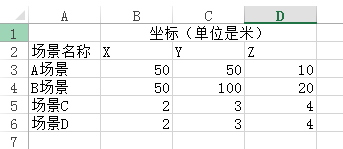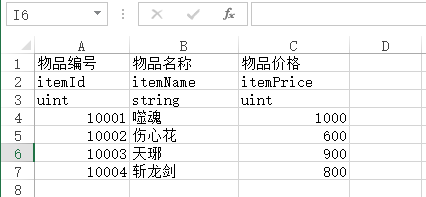网上找了一篇很好的博客 并对其修正+优化了一下https://blog.csdn.net/wangjiangrong/article/details/79980447
不多介绍先直接上手吧
准备工作
首先下载Excel.dll ,ICSharpCode.SharpZioLib.dll ,System.Data.dll 这些类库下载下来 放在Unity目录下的Plugin目录下,没有的话就新建一个
下载连接:https://download.csdn.net/download/qq_36848370/11985271
接着找到需要使用的表

目的
准备工作做完之后,我们要看看我们根据这个表,要的结果是什么?我们会把表中的内容读取到一个对应的class实例(ItemManager)中,然后将这个实例生成一个Asset资源,解释一下 每次代码编译都会读取一下Excel表中的内容 从而实例出asset,读取这个肯定要比直接读取Excel快的多。
如图:
会发现这个Asset包含了表里的所有内容,然后我们就可以使用这个Asset来获取我们需要的数据。比如将这个Asset文件放在Resources文件夹下,用如下代码遍历:
public GameObject A; //这个A 是一个gameobject 可以随意修改 也可以Excel表中配置路径 自由发挥
void Start()
{
ItemManager man = Resources.Load<ItemManager>("DataAssets/Unity_list");
foreach (Item i in man.dataArray)
{
Debug.Log(i.itemName + "---" + i.itemPos);
GameObject go = GameObject.Instantiate(A, i.itemPos, Quaternion.identity);
go.name = i.itemName;
go.transform.eulerAngles = i.itemPos;
}
}打出的Log如下:

当然我们也可以将这个Asset打成一个ab包来读取。
知识点:
1.ScriptableObject:我们要将一个class的实例生成一个UnityEngine.Object文件,然后将这个Object生成为Asset文件,我们的class需要继承ScriptableObject。
2.Serializable:可以序列化一个类,使这个被序列化的对象在Inspector面板上显示, 并可以赋予相应的值
3.读取excel的操作和打包AB一样,不能在程序运行时执行,代码要放在Editor文件夹下。
定义类
我们首先需要定义两个类,第一个类用来存放每行的表数据(Item)该类需要添加Serializable字段,才能在Asset中显示数据。
第二个类用来存放前者的数组即所有的表数据(ItemManager)。该类即要生成Object的类,需要继承ScriptableObject
新建工具类 读取表内容 当然可以设置第几张表
using UnityEngine;
using System.Data;
using System.IO;
using Data;
using Excel;
namespace Data
{
[System.Serializable]
public class Item
{
public string itemName;
public Vector3 itemPos;
}
public class ItemManager : ScriptableObject
{
public Item[] dataArray;
}
}
namespace EditorTool
{
public class ExcelConfig
{
/// <summary>
/// 存放excel表文件夹的的路径,本例xecel表放在了"Assets/Excels/"当中
/// </summary>
public static readonly string excelsFolderPath = Application.dataPath + "/Excels/";
/// <summary>
/// 存放Excel转化CS文件的文件夹路径
/// </summary>
public static readonly string assetPath = "Assets/Resources/DataAssets/";
}
public class ExcelTool
{
/// <summary>
/// 读取表数据,生成对应的数组
/// </summary>
/// <param name="filePath">excel文件全路径</param>
/// <returns>Item数组</returns>
public static Item[] CreateItemArrayWithExcel(string filePath)
{
//获得表数据
int columnNum = 0, rowNum = 0;
DataRowCollection collect = ReadExcel(filePath, ref columnNum, ref rowNum);
//根据excel的定义,第三行开始才是数据
Item[] array = new Item[rowNum - 2];
for (int i = 2; i < rowNum; i++)
{
Item item = new Item();
//解析每列的数据
item.itemName = collect[i][0].ToString();
item.itemPos = new Vector3(float.Parse(collect[i][1].ToString()), float.Parse(collect[i][2].ToString()), float.Parse(collect[i][3].ToString()));
array[i - 2] = item;
}
return array;
}
/// <summary>
/// 读取excel文件内容
/// </summary>
/// <param name="filePath">文件路径</param>
/// <param name="columnNum">行数</param>
/// <param name="rowNum">列数</param>
/// <returns></returns>
static DataRowCollection ReadExcel(string filePath, ref int columnNum, ref int rowNum)
{
FileStream stream = File.Open(filePath, FileMode.Open, FileAccess.Read, FileShare.Read);
IExcelDataReader excelReader = ExcelReaderFactory.CreateOpenXmlReader(stream);
DataSet result = excelReader.AsDataSet();
//Tables[0] 下标0表示excel文件中第一张表的数据
columnNum = result.Tables[0].Columns.Count;
rowNum = result.Tables[0].Rows.Count;
return result.Tables[0].Rows;
}
}
}我们将拿到的数据存放在ItemManager当中,并生成一个Asset:
using System.IO;
using Data;
using EditorTool;
using UnityEditor;
using UnityEditor.Callbacks;
using UnityEngine;
public class ExcelBuild : Editor
{
[MenuItem("CustomEditor/CreateItemAsset")]
[DidReloadScripts]// 现代代码自动编译会执行此方法
public static void CreateItemAsset()
{
ItemManager manager = ScriptableObject.CreateInstance<ItemManager>();
//赋值
manager.dataArray = ExcelTool.CreateItemArrayWithExcel(ExcelConfig.excelsFolderPath + "Unity_list.xlsx");
//确保文件夹存在
if (!Directory.Exists(ExcelConfig.assetPath))
{
Directory.CreateDirectory(ExcelConfig.assetPath);
}
//asset文件的路径 要以"Assets/..."开始,否则CreateAsset会报错
string assetPath = string.Format("{0}{1}.asset", ExcelConfig.assetPath, "Unity_list");
//生成一个Asset文件
AssetDatabase.CreateAsset(manager, assetPath);
AssetDatabase.SaveAssets();
AssetDatabase.Refresh();
}
}
这样我们就大功告成了!!!在Unity菜单项,选择我们自定义的菜单CustomEditor->CreateItemAsset(目前的asset 每次代码编译都会重新生成一遍)。即可生成我们需要的Asset。
附加
备注:上面这种方法,我们自己手动根据对应的表写对应的类,然后针对性解析。但是如果我们有几十个表,那么就会显得很愚蠢。所以有个优化方案就是,我们在表中存好字段名称和字段类型,然后遍历所有的表读取这两个信息,用代码自动生成我们需要的.cs文件。当类都生成好后,再去遍历表解析数据,利用反射存入对应的类中,然后生成对应的Asset。
注意:在AssetDatabase.CreateAsset()中,我们要传的路径应该是"Assets/"开头的Unity路径,而不是Windows中的全路径,类似于"E://..."。否则会报如下错误:Couldn't create asset file!
注意:在ScriptableObject类中,基本数据类型以外的成员类型需要加 SerializeField 关键字,自定义数据类型被ScriptableObject对象使用的时候,该类需要加 Serializable 关键字。如果没有加的话生成的Asset资源Inspector窗口就无法看见对应数据。
补充:
System.Data.dll如果冲突的话,删除即可。
经测试发现,分以下两种情况:
1. 如果xlsx文件的后缀为.xlsx,读取的代码应该为
IExcelDataReader excelReader = ExcelReaderFactory.CreateOpenXmlReader(stream);
若使用CreateBinaryReader读取,则在excelReader.AsDataSet();会报错NullReferenceException: Object reference not set to an instance of an object
2.如果xlsx文件的后缀为.xls,读取的代码应该为
IExcelDataReader excelReader = ExcelReaderFactory.CreateBinaryReader(stream);
若使用CreateOpenXmlReader读取,则在CreateOpenXmlReader处会报错ArgumentNullException: Value cannot be null.
原博客连接 https://blog.csdn.net/wangjiangrong/article/details/79980447

